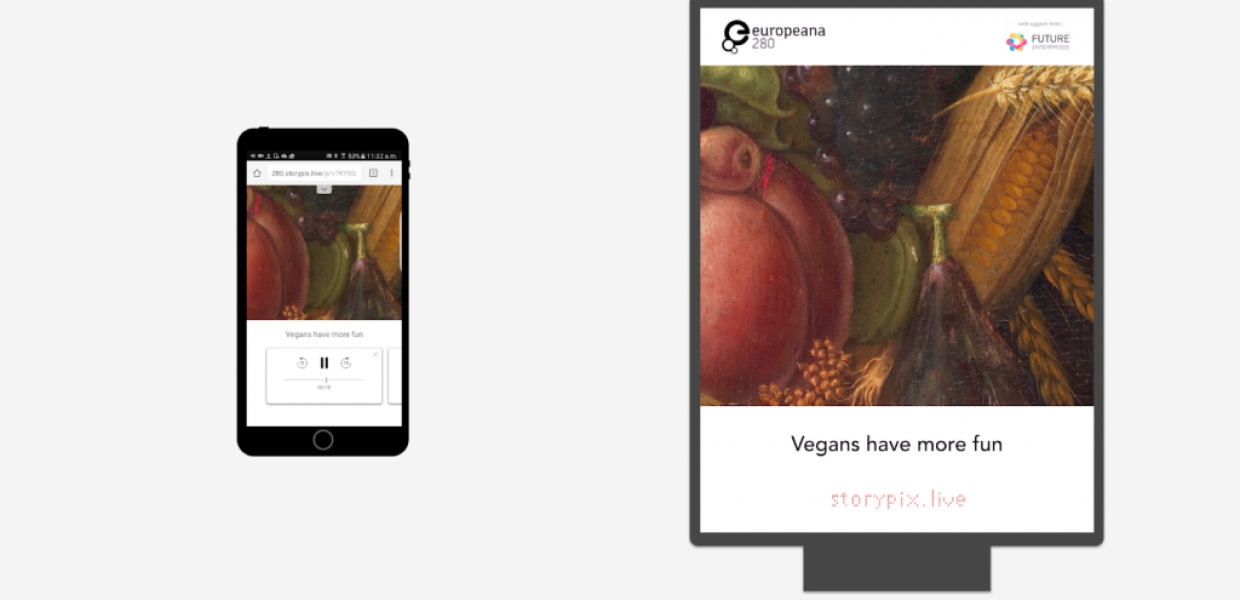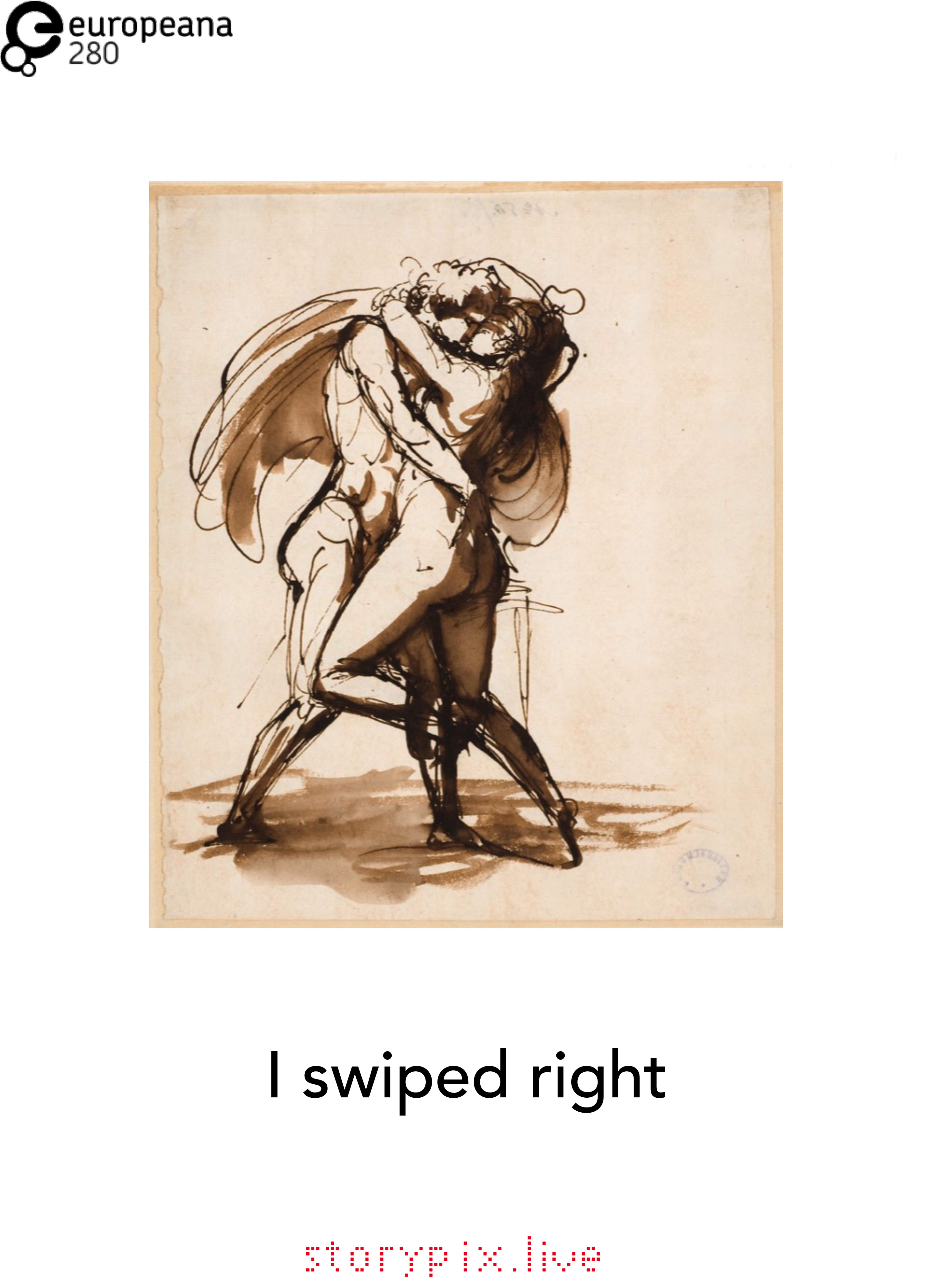Art can live anywhere!
Art, technology and storytelling. One of the winners of the first Europeana Challenge of 2016, Storypix combines these elements in a web exhibition platform that allows for art institutions to meaningfully present their collections in public spaces. In this interview, Paul Ruseler, part of the Storypix team, tells us about democratising art, museum innovation and other stories.

You are one of the Europeana Challenge winners of 2016. Why did you apply for the challenge?
It kind of came exactly at the right time. A friend had invited me to a hackathon in the Waag Society in Amsterdam that was organised by the Europeana Space project. The event itself was an eye opener. I had years of experience in curating photography exhibitions, but this was a great opportunity to expand this and experiment with the potential of technology for presenting art. We came up with an exhibition model for large digital screens with mobile interaction technology, centred around personal storytelling. I believe stories are central to our human experience and with technology we can really tap into that now. Snapchat and Instagram all revolve around storytelling, people love sharing those stories and we took an approach that connected to this trend. Responses were very good when we presented it and I felt we were onto something. When the Europeana Challenge opened a few months later I understood they were looking for creative ideas to disclose the Europeana collection. I have always felt that archives are treasure troves of inspiration, but become daunting and inaccessible by its sheer size and kind of data driven approach. Europeanaʼs collection of artworks had so much to offer that I really wanted to dive into it and bring it to life. To connect the best of the European art heritage to a new audience and engage them with personal storytelling and great technology. This is when I decided to join the challenge and submit the Storypix concept to Europeana Labs.
Could you tell us about your team?
I teamed up with Jack and George, a British developers duo who, as trained as engineers, knew the importance of durability for anything that is placed in public space. They also were keen on working with the idea of personal storytelling around art and they knew the book Art As Therapy by Alain de Botton, that served as a inspiration for the concept of Storypix. We spent many meetings drafting out the first ideas, wireframes and routings and iterated continuously throughout the process. They managed to build a platform from scratch, coding together different elements that eventually led to a responsive and robust framework and a great user experience. They were also keen thinkers in terms of design. One of the biggest challenges with new technologies is to keep things simple. Youʼre quickly tempted to include many features, but that usually doesnʼt make it better. Jack and George both had a good eye for app development so we spent many hours discussing what we could leave out, which eventually made for a more focused experience. Storypix wishes to bring art to outside museum walls, to public spaces.
How will it work?
Digital screen technology is now at a point where high resolution art works can be displayed with impressive effect. We looked for the best cinematic experience for this, with a fluent interaction and the immersive quality of sound. Because people have the device for this right in their pockets. To install a Storypix location, all thatʼs needed is a large screen or projection. This could be inside a building or outside, whatever works best for that environment. When someone then goes to storypix.live on their phone, the web application picks up the artwork by location and shows the interface on your screen. Now you stand in front of the artwork and your phone has turned into both a remote controller and story device. Itʼs all web based, no app is required. The visitor can now touch their phone and zoom in on the artwork on the big screen. Itʼs very intuitive and it feels like magic; you are moving a large surface with minimum movement and it allows you to see art at an incredible level of detail. On your phone screen, the bottom part has an audio player to access the stories. With a pair of headphones people can now experience art as if it were cinema, immersed in a soundtrack and moving through high resolution art pieces. The level of personal engagement is great and this creates an opportunity to connect to people. From here we can allow people to buy tickets for the museum or share their stories to their friends and families.
Combining celebrated artworks with personal stories is one of Storypixʼs features. How will this enhance the user experience of enjoying art?
Museumʼs are constantly innovating to reach out to new audiences (read: millennials) but their approach is often still that of an institution instead of a network of people. Information is given about the who, when and where, but itʼs quite rare that you are touched by that experience. I often felt this approach is not the purpose of the museum, which, as a “house of the muses”, is supposed to inspire our lives. The book from Alain de Botton suggests that we should ask what an artwork means to us personally. Because thatʼs what matters in the end. We are naturally inclined to listen to someone who talks about how they love someone, or what keeps them up at night. What they dream of and how they struggle to live in the city or deal with family. Simple contemporary subjects like online dating can turn into meaningful stories of life, seen through the works of art. I believe art can bring inspiration and wisdom to our lives, when we start to understand it actually is about us. This is why Storypix is all centred around personal stories from peopleʼs real lives. It even includes a functionality to add stories on the go. We believe this is a real change in terms of democratising art. We took on the Europeana 280 collection that has some of the best artworks across Europe, in beautiful high resolution. It proved a great collection to connect these paintings to contemporary life and we had a lot of fun thinking about how we can best do this. Finding the right combination between paintings, suggestive headlines and stories was like inventing a new type of storytelling. I canʼt wait to hear other peopleʼs stories, from the intimate, the hilarious to the honest and heartfelt. Thatʼs what I think art should be about.

"I swiped right" is a derivative of "Passionate Lovers" by Johan Tobias Sergel, used under CC BY-SA. "I swiped right" is licensed under CC BY by Storypix.
Storypix uses openly licensed artworks that are part of the Europeana 280 campaign. How important is for creative industries professionals that cultural heritage institutions open their content?
Very important I think. Some institutions like the Rijksmuseum have understood that by giving open access to high resolution files of their collection, they donʼt compromise their function as a museum, but in fact reinforce it. By adding stories to an artwork it means that you add value to it. The artwork becomes a reference point and part of a collective memory. People will be eager to come and see the original. Rijksmuseum has invested a lot into this and its new director is going to open up even more. It has proven a very good strategy for reaching broad audiences and becoming a successful institution and now many museums are doing the same. The Europeana 280 collection is a great example of this strategy; a proof of the cultural wealth that Europe has to offer and the result is very inspiring. And Iʼm convinced this is just the beginning. I enjoy visiting museums and I know thereʼs a lot of work thatʼs still only visible to the museum visitor. I hope museums will open up more and more in this respect, because having a new generation relate to art is not only rewarding and encouraging, itʼs also a great investment in the future.
Tell us about the technology developed for the app.
We developed a platform to present artworks at different locations at the same time. With a simple URL you connect your phone to a display that you control as if it were an advanced remote. Itʼs built with a type of web communication, originally developed for social media, that pushes data at lightning speed and which has recently become available for open source. This piece of tech gave us the responsiveness we needed. When you touch your phone screen, it feels like youʼre moving the big screen, giving the artwork a feel of tangibility. Other technologies that we included are a tiling service for handling gigapixel files and a multiple user mode to allow more than one person to join. We built a custom audio player from the ground up so we could design it as we wanted, we routed localisation through a secured https protocol and included sharing to social platforms. We worked on the back end to allow institutions to have their own account to upload content and we included a payment module for buying tickets to the museum and more - all in a deceptively simple app. Because itʼs web based we can constantly iterate, reshape the experience, collect data for our customers and update the app. It also means we are extremely flexible in terms of adding content, which is key for working with partners with various types of collections.
What are Storypix's next steps?
We want to partner up with museums and art institutions to start showcase art on their large screens inside their institutions, or, take it outside. We want to start to talk to municipalities to bring these collections into the city and to connect people to art. We want to talk to billboard companies and help them understand that their screens can be more than displays for brands, that it can be a place of culture. And we want to see how we can partner with other European institutions to make use of our great cultural heritage and to and open it up to a large and diverse audience.
Do you want to learn more about Storypix app? Check out www.storypix.org.
